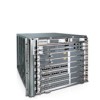Dell Force10 E300 Installing and Maintaining the E300 System - Page 19
Installing Power Modules
 |
View all Dell Force10 E300 manuals
Add to My Manuals
Save this manual to your list of manuals |
Page 19 highlights
5 Installing Power Modules This chapter contains the following major sections: • Installing AC Power Modules • Installing DC Power Entry Modules on page 22 • Power Supply and Fan Operability Test on page 27 The E300 system requires a minimum of one DC Power Entry Module (PEM) or a minimum of two AC Power Supplies (see AC and DC Power on page 14). WARNING: The E300 must contain only one type of power module-AC or DC. WARNING: Electrostatic discharge (ESD) damage can occur when components are mishandled. Always wear an ESD-preventive wrist or foot-heal ground strap when handling chassis components. Installing AC Power Modules The E300 AC Power Supply Module is capable of operating at either 100 VAC or 220 VAC. If the E300 is connected to a 100 VAC power supply, three power supply modules are required, or four power supply modules are required for power supply redundancy. If the E300 is connected to a 220 VAC power supply, two power supply modules are required, three power supply modules are required for power supply redundancy, and four power supply modules are required for full facility redundancy. For full facility redundancy, each power supply must be attached to an independent power source with a dedicated circuit breaker sized in accordance with your local building and electrical safety codes. To comply with safety agency and emission requirements, a power supply blank cover must be inserted into any unused power supply slot. CAUTION: Before removing and replacing a power supply module, determine if the E300 is in full facility redundancy or non-redundant power. Operating in non-redundant power will require a complete system power off when removing and replacing a power supply. Installing Power Modules | 19















